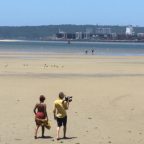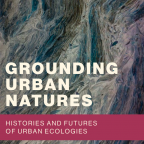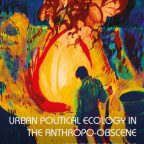There are currently two working titles for the book:
Histories and Futures of Contested Urban Natures
Doppelgänger Natures: uncovering urban natures past and future across the world
With increasing urbanization and ecological crises the importance to gather a range of urban experiences is vital. The book project includes chapters on how ways of knowing and particular histories of infrastructure planning and informal settlements are intertwined with the ecologies of water, green space, marsh lands, conservation areas, and waste. This means to raise difficult questions about what ‘urban nature’ is, who can enroll it into particular political projects, and who can claim to be in the know of ‘urban nature’, and its values.
The book project has built a unique set of case from Rio de Janeiro, Buenos Aires, Lagos, New Orleans, Berlin, San Francisco, Dalian (China), Delhi, Cape Town, and Seattle. Beyond the focus on single cities, the book also works to explore how ‘planning models’ like ‘the garden city’, ‘the resilient city’ and planning tools like ‘ecosystem services’ travel across the world to influence local practices, but also how these tools gets negotiated locally and the politics they generate. The book is divided into three sections—Unexpected Natures, Popular Natures, and Technological Natures—that explore different aspects of the contested character of urban natures.
By primarily using historical research and social theory, the book aims to intervene in a growing policy area on ‘how to fix the city’ so it contributes to a more sustainable city and world. When carefully researched across various social, cultural and indeed ecological contexts, simple policy solutions can be difficult to formulate. On the other hand, a refined understanding on how ‘urban nature’ changes and is reworked across various cities in the world, opens towards an informed debate, which seems of vital importance.
Longer description
Doppelgänger Natures focuses on urban nature as process, as produced through part cultural and part biophysical processes. As such urban nature becomes part of social, political, even ideological projects, and carries a history, or histories.
The book has three sections—Unexpected Natures, Popular Natures and Technological Natures—that are described below and the following authors are involved.
Henrik Ernstson and Sverker Sörlin (editors, introduction and conclusion)
Amita Baviskar—Delhi, India
Andrew Karvonen—Seattle, USA
Anne Whiston Spirn—USA
James Evans—LTER and US
Jai Ching Chen—Yixing city, China
Lance van Sittert—Cape Town, South Africa
Lisa Hoffman—Dalia, China
Lindsay Sawyer—Lagos, Nigeria
Lise Sedrez—Rio de Janeiro and Buenos Aires
Richard Walker—San Francisco, USA
The first section, Unexpected Natures, include chapters that demonstrate the variety of urban natures. The argument is obvious but important as starting point: urban nature is broader than the fixed things of ‘green space’, parks and cemeteries. Urban nature is process—part cultural, part biophysical—and includes built-up natures, infrastructured natures of pipes and sewage, of piped water, of waste, private and public gardens, ornamental spaces, but also weeds, and all kinds of animals, including domesticated species, wild species, and unwanted synanthropic species such as lice and rats. Some of this nature is indeed related to humans in a very real sense; urban nature is also human disease and vermin. The section will show how difficult it is to talk about ‘green space’, urban nature, urban ecosystems in simplistic ways, as ‘service providers’, or as detached from social and political processes; but instead that they have carried multiple meanings over time and space.
The second section on Popular Natures demonstrates how popular movements, ‘grassroots’, or similar ‘in-place’ ways of mobilizing, have reworked and resignified urban nature, shifting potentially who can claim to be in the know of urban nature. This is both a politics of physical space and of material reality, but also a cultural struggle of recognition and a mixing of the social and the natural into vehicles of mobilization. Green spaces themselves play a role in the construction of collective action, while they also become part in cultural universes that tries to re-imagine the city as a more equal space. This section includes historical accounts of how popular movements have, not in isolation of the state and private business, but in contestation and negotiation, reworked how urban nature can be understood, and how it can be valued, shifting who can be in the know of urban nature. The accounts of popular natures can serve as a lens to understand how certain groups over time have appropriated nature for their own interests, or the interest of the public. What comes into view is how collective action have been constructed (perhaps in negotiation with nonhumans), the way by which values are articulated, who speaks for certain natures, and what expertise and discourses are inserted to claim legitimacy. The question of whose nature is being protected, and for what purpose is therefore highly relevant, but so is the agency of non-humans in accomplishing such political projects. Green spaces and urban nature is both conservative and revolutionary—caught up in the making of cities.
In the third section, on Technological Natures, the book traces and explores how more abstract models of urban nature, those used—by necessity—by different levels of planning, by those we often refer to as ‘experts’. Indeed the notion of planning, its bureaucracies and city-wide goals to grasp the city, seems to require technologies of abstraction and simplification to at all work. Abstract and simplified models of city-making—from Ebenezer Howard’s garden city, to the sanitarians, the Prometheus large-scale systems for transport of water, people and electricity, to todays gentrified port-developments, the ‘compact city’, ‘resilient city’ or ‘biophilic city’—fill this role. In these technological natures, ‘green spaces’ and urban ecosystems seem to behave according to a plan, obediently following the envisioning of architects, ecologists, planners, or world-bankers. Such models however, often fail to recognize the ecological embeddedness and biophysical composition of green spaces—they are living entities that react and create new things, good and bad, amendments and nuisance, and they keep changing. In particular, the models based on green desires and designs also often fail to recognize that urban natures come in many shapes and sizes and life-forms—from parks to waste, from nature reserves to electricity production. They often also fail to recognize the social and political embeddedness of green spaces—as caught up in class projects, as tools for ideologies, as popular revolt, or as ‘silent encroachments’ by the poor as explored in the previous sections. The construction, circulation and use of these models, is part of a wider history of how technomanagerial ‘solutions’ to urban problems flows across countries and cities over time to influence urban planning and ideological projects and should be explored as such in the book. This section demands a different type of case study than the previous sections—one that moves beyond particular ‘cities’ and rather traces how ‘models’ of city-making, or city-design, like the sanitarian city, the resilient city, eco-city, ‘green urbanism’ travels across space and time to influence local discourses and the formation of urban natures and their meanings. Furthermore, since urban natures are living entities, forever changing, the implementation of these models have had to negotiate not only local bureaucracies, and local politics, but also the inherent agency of nonhumans, which the authors should also try to integrate in their accounts. How have nature acted back on these models? What are the unintended (ecological and social) consequences of these models? Consequently, this section on technological natures can be put into communication with the other sections on unexpected and popular natures.
‘Worlding of urban nature’
In parallel to the aim to historically compare ‘urban natures’ across space, and use social theory, the aim Doppelgänger Natures is towards a ‘wordling of urban nature’. This means to allow multiple voices, from different parts of the world to rework urban nature, its notion, meaning and use. The book works to create multiple registers and understandings of what contested urban natures might mean across time and space. This move aims to de-center the EuroAmerican origin of ‘urban nature’ towards its ‘worlding’ and usefulness in various contemporary debates, in various places in the world.
Critique, construction and politics
The book is about critique of standard and taken-for-granted views. The book is therefore timely to the international scholarly community that is researching cities, and for policy discussions, and activists. Nature and culture seems to be more interlinked than ever and the intersection of increased urbanization and ecological crisis have created a plethora of ideas on how urban nature, ‘greenery’, biodiversity, urban farming and ‘ecosystem services’ can help to ‘fix’ the city, making it more sustainable, just, and inclusive. The book’s detailed case studies strives to counter these often free flowing policy models that seldom regard a time perspective or regional differences. The chapters works to show how urban nature is situated in time and place, part of—and reworked through—social, political and biophysical processes. The hope is therefore to provide useful critique, or at least chisel a fracture within the discourses of ‘green urbanism’, ‘landscape urbanism’, ‘resilient cities’, and the almost frictionless circulation of the innate positive values of ‘green space’ and urban nature. The book is about to pluralize urban nature—to urban natures—and demonstrate approaches of study that can be more truthful about the multiple roles, functions and understandings that urban nature carries.
The book’s theoretical intervention is however also about being constructive. The book is meant to assemble or create an approach—or approaches—to urban nature that insists that studies and interventions need to work through different registers, over time, and with different questions in mind. Collectively we might even be able to reach further than that, and aim to clarify anchor points for future theory-making (rather than a meta theory that can contain all chapters). These anchor points should be able support discussions towards democratic political practices flavored by the many places from which we write.
Our book should thus not come across as a nihilist project. Rather it should be asking ‘what is the political of urban nature’? And what politics is possible, and has been possible across time and in different places in relation to urban nature? If the political is, as Erik Swyngedouw (2009) insists, when the staging of equality and liberty for all, fractures the current order of recognized voices, then what politics can flow from such moments of upheaval and questioning, and what noise can be turned into new voices in the search for more democratic forms of urban nature-making? Lying in wait here is an emancipatory subproject of the book—can we, across our various case studies of urban natures, say something about how to support material practices towards emancipatory and sustainable futures? This in itself is a project of worlding—to learn from our case studies to create imaginaries of “alternative social visions and configurations—that is, ‘worlds’—than what already exists in a given context.” (Roy and Ong 2011).



